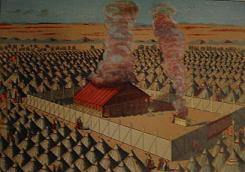Most Holy Place
|
|
The Most Holy Place also known as the Holiest of Holies, or Holy of Holies, in Hebrew: Kodesh HaKodashim (קדש הקדשים), is a location within the inner Tabernacle in the time of Moses. In the Book of Exodus it is referred to as the most holy (Exodus 26:33), and the most holy place (Exodus 26:34), (and as the holiest of all in (Hebrews 9:3).)
The Most Holy Place is said to be the place where the presence of God dwelt. In the wilderness, on the day that the tabernacle was first raised up, the cloud of the Lord covered the tabernacle. There are other times that this was recorded, and instructions were given that the Lord would appear in the cloud upon the mercy seat, and at that time the priests should not enter into the tabernacle (Leviticus 16:2).
In terms of ancient temple architecture, the Most Holy Place corresponded with the Greek Naos or the Roman Cella: the house for the deity and the center of the religious structure.
Tabernakel_536x282.jpg
The Tabernacle, reconstruktion
The TabernacleReconstruction
| Contents |
Utilization
The Most Holy Place was a place where the high priest would go in, once a year, on the Yom Kippur, to sprinkle the blood of an animal upon the Ark of the Covenant and the mercy seat which sat on top of the ark. The animal was sacrificed on the Brazen Altar and the blood was carried into the most holy place. The golden censers were also found in the Most Holy Place.
Sanctuary
Tabernacle's floorplan
|
Description
In order that God may dwell permanently among the Israelites, they are given instructions for erecting a sanctuary. The directions provide for:
- A wooden ark, gilded inside and outside, for the Tables of the Covenant, with a cover similarly gilded as "mercy seat" for the Divine Presence;
- A gilt table for the so-called "shewbread" ( );
- A golden candlestick for a light never to be extinguished; #The dwelling, including the curtains for the roof, the walls made of boards resting on silver feet and held together by wooden bolts, the purple curtain veiling the Holy of Holies, the table and candlestick, and the outer curtain;
- A sacrificial altar made of bronzed boards for its korban;
- The outer court formed by pillars resting on bronze pedestals and connected by hooks and crossbars of silver, with embroidered curtains;
- Preparation of the oil for the candlestick.
Modern location
Presently it is conjectured that it is located near the Muslim Mosque of Omar under the Dome of the Rock which stands on the Temple Mount in Jerusalem, though the exact location of the Most Holy Place is not known with any certainty. Orthodox Jewish visitors to the Temple Mount, who come especially from those groups associated with the movement to rebuild the Temple, seek to conform to the minimal requirements for entering the holy place, such as only wearing linen and not showing their back towards its presumed location out of reverence. Most Orthodox Jews today completely avoid climbing up to Temple Mount, to prevent themselves from accidentially stepping on the Most Holy Place. They consider this as something forbidden to all but a future high priest, to be ordained only after the coming of Messiah.
In Jewish synagogues
Within Judaism all synagogues are constructed in such a way that the most holy spot is the "Ark" in the sanctuary. The place where the Torah scrolls (Sifrei Torah in Hebrew) are stored is known as the "Ark" (aron in Hebrew). It is usually built along the wall of the synagogue closest in direction to Jerusalem. This spot is considered to be a miniature embodiment of the original Tabernacle's and Temple in Jerusalem's Kodesh HaKodashim -- the Holy of Holies. During all Jewish services in all synagogues, the worshipers face in the direction of the Ark, the symbol of the Holy of Holies, which contains the holy Torah scrolls belonging to every Jewish congregation. When the Ark is opened so that the Sefer Torah may be taken out for Torah reading, all worshipers (except the elderly or ill) usually rise as a mark of respect for its holiness and importance.
Mormon perspective
The Salt Lake Temple of The Church of Jesus Christ of Latter-day Saints contains a "Holy of Holies" wherein the church's President—acting as the "Presiding High Priest"—enters to fulfill the relationship between himself and God. This is done in accordance with LDS interpretation of the Book of Exodus (Ex 25:22 (http://scriptures.lds.org/ex/25/22#22)).
Although the LDS church operates over 100 temples, only the Salt Lake temple has this feature. During the construction of the Salt Lake City temple from 1853-1893, the LDS temple in Manti, Utah housed a "Holy of Holies," though it is no longer used as outlined above.
Some modern Jews regard this as blasphemous.
See also
External links
- The Purpose of Temples: The Church of Jesus Christ of Latter-day Saints (http://www.lds.org/temples/purpose/0%2C11298%2C1897-1%2C00.html)


